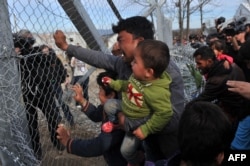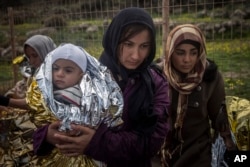The United Nations refugee agency and U.N. children's fund are setting up 20 centers to support and protect children and families fleeing war and persecution as they move across Europe’s well-worn migration routes.
The so-called Blue Dot hubs are intended to be a safe place for children and families facing many risks once they arrive in Greece and move along the Balkan migratory route, which includes the former republic of Macedonia, Serbia, Croatia and Slovenia.
A huge blue dot identifies the locations as places where children can play and they and their families can receive vital services, protection and counseling in a single location.
Children at risk
Volker Turk, the UNHCR assistant high commissioner for protection, says families on the move are very vulnerable, especially children. He says many are unaccompanied and others become separated from their families. He says children are at risk of sickness, trauma, sexual exploitation, trafficking and violence.
Turk says he became particularly conscious of the fear gripping refugee children when he was at the Greek-Macedonian border a couple of weeks ago.
“You immediately are confronted with children who wander about," he said. "It is cold and dark and these children [either] lost their parents on the way. They got put into buses, which leads to family separation. They wandered around in a very unfamiliar, dark environment sometimes because it was evening.”
Turk says since the first blue dot hubs began operating two weeks ago, about 40 to 50 separated children are being reunited with their parents every day. He says all 20 hubs will be operational in the next three months.
U.N. agencies report women and children now make up nearly 60 percent of those who travel from Turkey to Greece by sea, compared to 27 percent in September.
Need for international protection
Marie-Pierre Poirier is UNICEF's coordinator for the refugee and migrant crisis in Europe. She says 85 percent of the children need international protection.
“Children just need a safe place to play and be children again even if it is just a few hours. In some cases, it may be much longer with some of the developments. Mothers need a private place to rest, to feed their babies,” she said.
The agencies say the hubs can restore family links, counsel traumatized children and provide emergency shelter and basic care — so the youngsters going through a tumultuous period feel a sense of normality, even if for a short time.










